
In Catholic theology, Limbo is the afterlife condition of those who die in original sin without being assigned to the Hell of the Damned. Medieval theologians of Western Europe described the underworld as divided into three distinct parts: Hell of the Damned, Limbo of the Fathers or Patriarchs, and Limbo of the Infants. The Limbo of the Fathers is an official doctrine of the Catholic Church, but the Limbo of the Infants is not. The concept of Limbo comes from the idea that, in the case of Limbo of the Fathers, good people were not able to achieve heaven just because they were born before the birth of Jesus Christ. This is also true for Limbo of the Infants in that simply because a child died before baptism, does not mean they deserve punishment, though they cannot achieve salvation.
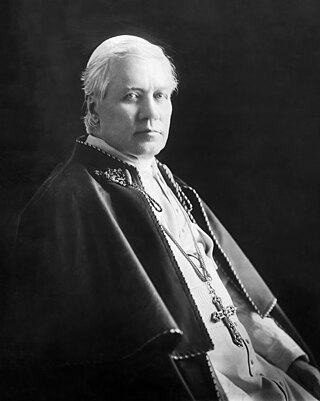
Pope Pius X was head of the Catholic Church from 4 August 1903 to his death in August 1914. Pius X is known for vigorously opposing modernist interpretations of Catholic doctrine, and for promoting liturgical reforms and scholastic theology. He initiated the preparation of the 1917 Code of Canon Law, the first comprehensive and systemic work of its kind. He is venerated as a saint in the Catholic Church. The Society of Saint Pius X, a traditionalist Catholic fraternity, is named after him.
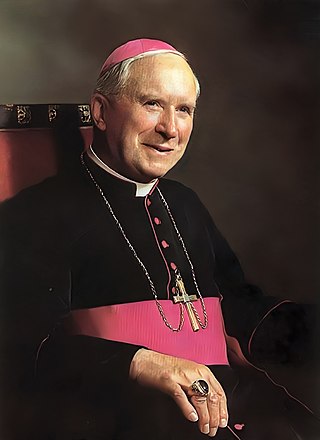
Marcel François Marie Joseph Lefebvre was a French Catholic archbishop who influenced modern traditional Catholicism. In 1970, five years after the close of the Second Vatican Council, he founded the Society of Saint Pius X (SSPX), a community to train seminarians in the traditional manner, in the village of Écône, Switzerland. In 1988, Pope John Paul II declared that Archbishop Lefebvre had "incurred the grave penalty of excommunication envisaged by ecclesiastical law" for consecrating four bishops against the pope's express prohibition but, according to Lefebvre, in reliance on an "agreement given by the Holy See [...] for the consecration of one bishop."

Pope Benedict XV, born Giacomo Paolo Giovanni Battista della Chiesa, was head of the Catholic Church from 1914 until his death in January 1922. His pontificate was largely overshadowed by World War I and its political, social, and humanitarian consequences in Europe.

The Catechism of the Catholic Church is a reference work that summarizes the Catholic Church's doctrine. It was promulgated by Pope John Paul II in 1992 as a reference for the development of local catechisms, directed primarily to those responsible for catechesis and offered as "useful reading for all other Christian faithful". It has been translated into and published in more than twenty languages worldwide.
Joseph Anthony Ferrario was the third bishop of the Roman Catholic Diocese of Honolulu and served from 1982 to 1993.

The Roman Catechism or Catechism of the Council of Trent is a compendium of Catholic doctrine commissioned during the Counter-Reformation by the Council of Trent, to expound doctrine and to improve the theological understanding of the clergy. It was published in 1566.
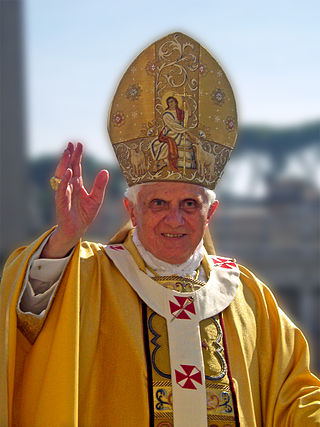
The theology of Pope Benedict XVI, as promulgated during his pontificate, consists mainly of three encyclical letters on love (2005), hope (2007), and "charity in truth" (2009), as well as apostolic documents and various speeches and interviews. Pope Benedict XVI's theology underwent developments over the years, many of which were characterized by his leadership position in the Congregation for the Doctrine of the Faith, which is entrusted with preserving the Catholic faith in its entirety.
The Pontifical Commission Ecclesia Dei was a commission of the Catholic Church established by Pope John Paul II's motu proprioEcclesia Dei of 2 July 1988 for the care of those former followers of Archbishop Marcel Lefebvre who broke with him as a result of his consecration of four priests of his Society of St. Pius X as bishops on 30 June 1988, an act that the Holy See deemed illicit and a schismatic act. It was also tasked with trying to return to full communion with the Holy See those traditionalist Catholics who are in a state of separation, of whom the Society of Saint Pius X (SSPX) is foremost, and of helping to satisfy just aspirations of people unconnected with these groups who want to keep alive the pre-1970 Roman Rite liturgy.
Inter pastoralis officii sollicitudines was a motu proprio issued 22 November 1903 by Pope Pius X that detailed regulations for the performance of music in the Roman Catholic Church. The title is taken from the opening phrase of the document. It begins: "Among the concernsof the pastoral office, ... a leading one is without question that of maintaining and promoting the decorum of the House of God in which the august mysteries of religion are celebrated...." The regulations pointed toward more traditional music and critiqued the turn toward modern, orchestral productions at Mass.
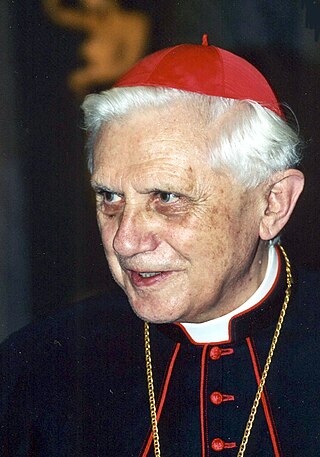
Joseph Ratzinger (1927–2022) was named by Pope John Paul II on 25 November 1981 as prefect of the Congregation for the Doctrine of the Faith (CDF) formerly known as the Holy Office and, especially around the 16th century, as the Roman Inquisition.
Silvio Antoniani was a musician, canon lawyer, writer on education, priest and cardinal of the Roman Catholic Church, who spent most of his career in the Roman Curia.
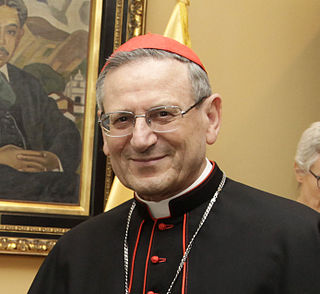
Angelo Amato, S.D.B., is an Italian cardinal of the Catholic Church who served as the Prefect of the Congregation for the Causes of Saints between 2008 and 2018. He served as Secretary of the Congregation for the Doctrine of the Faith from 2002 to 2008 and became a cardinal in 2010.
Felice Figliucci was an Italian humanist, philosopher, and theologian.
Florian "Floriano" Abrahamowicz is an Austrian priest who was formerly the Prior of the Society of St. Pius X in northeastern Italy. He was expelled from the Society in February 2009 for expressing numerous conspiracy theories, including Holocaust denial.
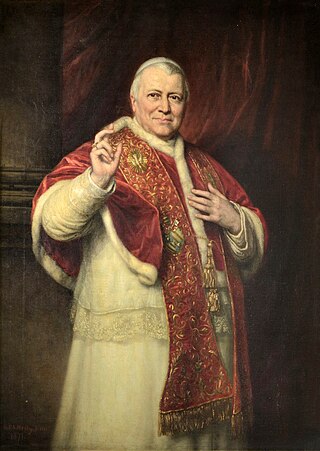
Papal infallibility is a dogma of the Catholic Church which states that, in virtue of the promise of Jesus to Peter, the Pope when he speaks ex cathedra is preserved from the possibility of error on doctrine "initially given to the apostolic Church and handed down in Scripture and tradition". It does not mean that the pope cannot sin or otherwise err in some capacity, though he is prevented by the assistance of the Holy Spirit from issuing heretical teaching even in his non-infallible Magisterium, as a corollary of indefectibility. This doctrine, defined dogmatically at the First Vatican Council of 1869–1870 in the document Pastor aeternus, is claimed to have existed in medieval theology and to have been the majority opinion at the time of the Counter-Reformation.
The canonical situation of the Society of Saint Pius X (SSPX), a group founded in 1970 by Archbishop Marcel Lefebvre, is unresolved. The Society of Saint Pius X has been the subject of much controversy since 1988, when Bernard Fellay, Bernard Tissier de Mallerais, Richard Williamson and Alfonso de Galarreta were illicitly consecrated at Ecône, at the International Seminary of Saint Pius X as bishops in violation of canon law. Lefebvre and the four other SSPX bishops individually incurred a disciplinary latae sententiae excommunication for the schismatic act; the excommunications of the four living SSPX bishops were remitted in 2009.
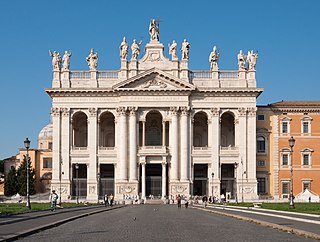
The Latin Church is the largest autonomous particular church within the Catholic Church, whose members constitute the vast majority of the 1.3 billion Christians in communion with the pope in Rome. The Latin Church is one of 24 churches sui iuris in communion with the pope; the other 23 are collectively referred to as the Eastern Catholic Churches, and have approximately 18 million members combined.
The following outline is provided as an overview of and topical guide to the Catholic Church:
Leonardo Marini was an Italian theologian and archbishop of the Dominican Order of the Catholic Church.











